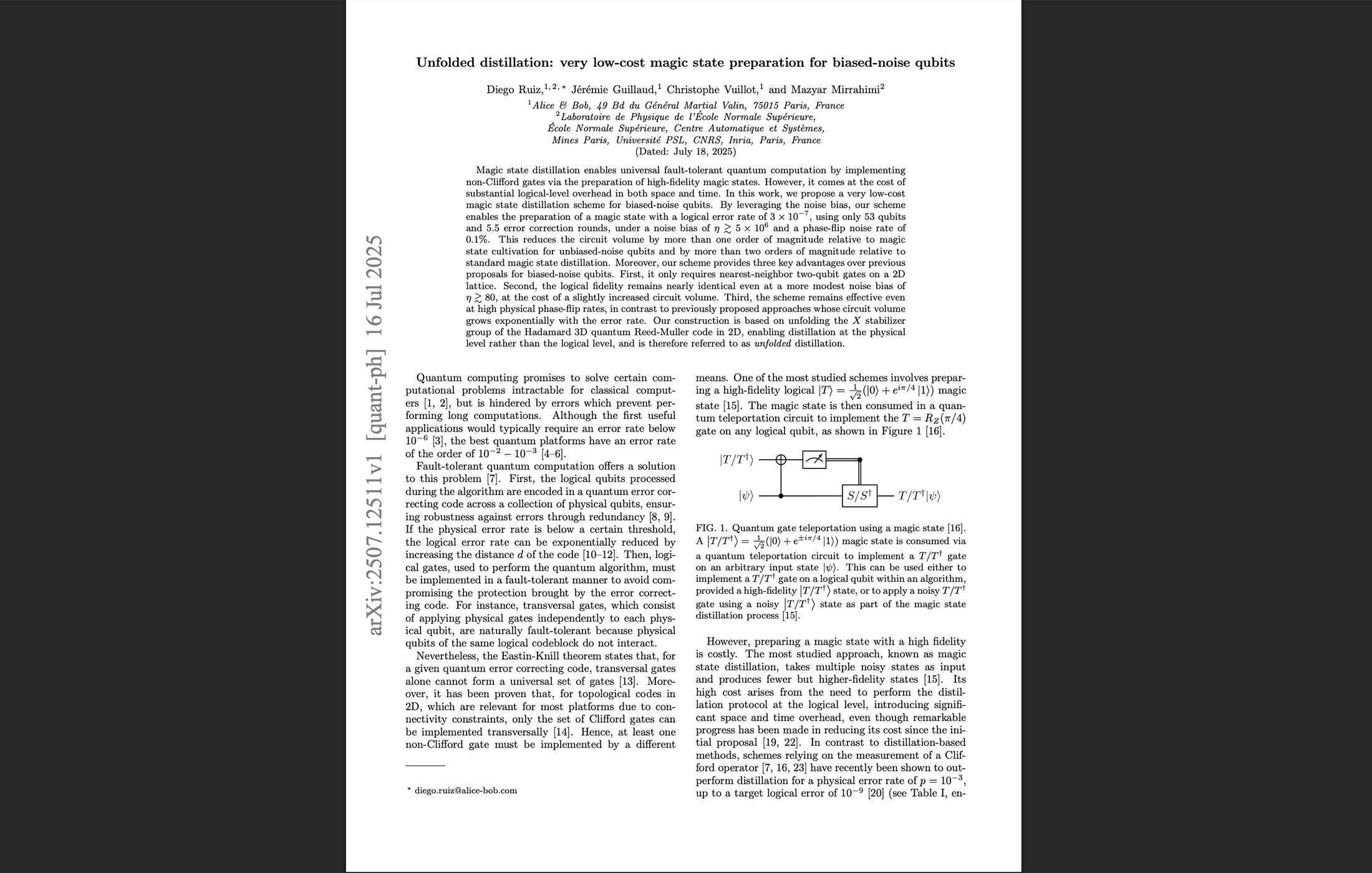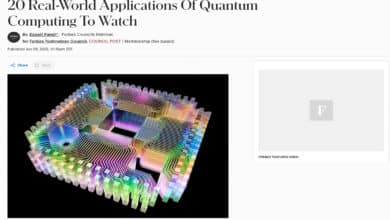Alice & Bob’s New “Unfolded” Code Dramatically Lowers Magic State Overhead

August 2025 – A new research paper from quantum startup Alice & Bob in collaboration with Inria unveils a technique to significantly reduce the cost of magic state generation – a crucial resource for universal fault-tolerant quantum computing. The paper, titled “Unfolded distillation: very low-cost magic state preparation for biased-noise qubits”, describes an error-correction scheme dubbed the “unfolded code” that leverages the unique properties of noise-biased cat qubits. By exploiting the naturally high bias of cat qubits against bit-flip errors, the researchers “unfold” a complex 3D distillation code into a simpler 2D layout.
The results are striking: the new method can produce a high-fidelity magic state using only 53 physical qubits – an 8.7× reduction in qubit count compared to the best previous approach (which required ~463 qubits per magic state). In addition, the protocol needs far fewer error-correction cycles (about 5.5 rounds instead of dozens), yielding roughly a 5× faster magic state preparation at comparable fidelity.
This advance directly targets one of the most resource-intensive aspects of fault-tolerant quantum computing. Magic state distillation (see my primer on magic states here) is the standard method to generate the special quantum states required for non-Clifford gates (like T or Toffoli gates) in a quantum computer. However, distilling these magic states typically consumes enormous overhead in qubits and gate operations. Alice & Bob’s unfolded code dramatically cuts down that overhead by taking advantage of their hardware’s noise bias. The scheme is designed for the company’s superconducting cat qubits, which exhibit an intrinsic asymmetry in error rates – bit-flip errors are exponentially suppressed, while phase-flip errors occur more frequently (but can be corrected with simpler repetition codes). The new distillation protocol harnesses this bias: by focusing error-correction effort on the dominant phase errors, it achieves the target magic state fidelity (error rate ≲$$10^{-6}$$) with far fewer resources. Importantly, the scheme has been implemented using only nearest-neighbor gates on a two-dimensional chip, making it practical for real hardware. The researchers report that their unfolded distillation remains effective even if the noise bias is not extremely high – it works with bias as “modest” as about 80 (instead of millions) with only a slight increase in qubit count, and it tolerates higher physical error rates without exponential resource blowup.
In short, the unfolded code offers a way to prepare magic states orders of magnitude more efficiently than the traditional schemes, potentially clearing a key bottleneck on the road to useful quantum computers.
Why This is a Big Deal
From my perspective, this development is a significant leap toward practical, universal quantum computing. Magic state distillation has long been viewed as a “necessary evil” – an expensive subroutine required to realize non-Clifford operations in error-corrected quantum processors. In conventional setups (like 2D surface codes on transmon qubits), studies showed that generating one high-quality T-state could demand hundreds of physical qubits and many rounds of distillation. For example, a recent Google-affiliated proposal called “magic state cultivation” was estimated to require ~463 qubits per magic state for comparable error rates. This enormous overhead meant that a large-scale quantum algorithm (like breaking RSA) would devote the majority of its hardware just to feeding itself magic states! Reducing that cost by nearly an order of magnitude, as Alice & Bob’s team demonstrated (53 vs. 463 qubits), is more than just an incremental improvement – it’s a transformative optimization. Fewer qubits and cycles for magic states translate directly into lower overall hardware requirements and faster execution for any quantum algorithm that needs many non-Clifford gates (which is most interesting algorithms). In practical terms, this could accelerate timelines for quantum advantage: tasks that might have required, say, a million physical qubits with standard distillation might be achievable with mere hundreds of thousands using these new techniques.
It’s also noteworthy how this improvement was achieved. Rather than relying on exotic new materials or qubit types, the unfolded code builds on existing components of Alice & Bob’s architecture. The protocol uses the same cat qubits and basic operations already in their error-corrected qubit design, meaning no fundamentally new hardware is needed – a big engineering plus. In essence, the researchers found a clever way to repurpose and rearrange known quantum error-correcting codes (specifically a 3D Reed-Muller code “unfolded” into 2D) to better fit the strengths of noise-biased qubits. The fact that it only requires local 2D connectivity and standard two-qubit gates means this approach could be implemented on a chip without requiring complex routing or long-range interactions. It demonstrates the power of tailoring quantum codes to the underlying hardware physics: when your qubits give you lemons (uneven error rates), make lemonade (simpler distillation).
We’re seeing a broader trend here – several key players in quantum computing have been racing to shrink the cost of magic state generation. This new result pushes the state-of-the-art, especially for platforms that can provide a noise bias (like cat qubits). It also reinforces Alice & Bob’s strategic bet on biased-noise qubits, validating that their approach can slash overhead not just for error correction but now for the essential magic states as well .
From a larger vantage point, solving the magic state bottleneck is pivotal for making fault-tolerant quantum computing practical. We often hear about improving physical qubit quality or designing better error-correcting codes for logical qubits – but without an efficient way to implement a non-Clifford gate, a quantum computer can’t be fully universal. The community has known this since the Eastin-Knill theorem guaranteed we’d need an additional resource like magic states for universality. Early distillation protocols were so resource-hungry that they cast doubt on whether “useful” quantum computing was even feasible outside of theoretical models. That’s why I’m excited about innovations like this unfolded distillation scheme. It essentially unlocks the next milestone on Alice & Bob’s roadmap (and indeed for many others): enabling a universal gate set on logical qubits without a prohibitive cost. In Alice & Bob’s case, their roadmap’s upcoming “Beryllium” phase involves building on-chip magic state factories – and with the unfolded code, those factories could be far more efficient and compact than previously thought possible.
It’s worth noting that this paper is a theoretical breakthrough at this stage. The authors have submitted it for peer review, and a press release suggests they intend to move toward experimental demonstration with Inria’s help. There are still practical challenges ahead: real devices have finite bias (not infinite), and engineering a 53-qubit entangled procedure reliably is non-trivial. However, given Alice & Bob’s recent hardware progress (e.g. achieving minutes-long bit-flip lifetimes in cat qubits ), it seems plausible they could implement this scheme on their next-generation chips. If and when this unfolded magic state distillation is shown on actual hardware, it would mark a major step toward fault-tolerant, universal quantum computers. In the bigger picture, every 10× reduction in overhead brings quantum computing closer to practical reality – and here we’re talking about a key 10× improvement in one of the most stubborn cost centers. That’s why this result has the community paying attention.



